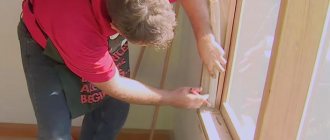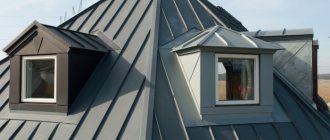With the onset of cold weather, a thrifty owner strives to escape the cold without causing significant damage to the family budget. Let's look at how to seal old wooden windows for the winter. All methods are aimed at doing it yourself at home using improvised means and inexpensive insulation materials.
According to thermal photographs of houses, a significant part of the heat leaves the room through walls, windows, doors, and roof. Insulating these units allows you to increase the heat-saving properties of the house. However, complete insulation is an expensive task, plus it is not always possible to do it yourself.
But sealing the windows for the winter is a relatively simple and easy-to-implement measure that anyone can do, and the effect is confirmed by an increase in the room temperature by 2-4 °C, depending on the chosen method of insulation.
Materials for insulating windows for the winter
10 ways to seal your windows for the winter
Summarizing the experience of previous generations, you can write an entire encyclopedia on the topic: how to seal the windows to prevent the draft.
Let's consider proven and affordable methods of insulation, for ease of comparison, arranging them in the form of a rating, in ascending order of the cost of performing the work:
Window paper
More precisely, paper putty. This is the cheapest method, since all you need to seal the windows is a selection of old newspapers and water. To increase the effectiveness of the putty, you can add 2 parts of crushed chalk or 1 part of clay to it. The resulting mass is highly plastic, which makes it easy to seal even the smallest cracks. The window can be easily washed off the putty during operation (as long as it remains wet). Insulating windows with paper is an effective way, but only for one season; in addition, a covered window does not make it possible to open the sashes in winter. As the weather gets warmer, the putty is removed from the cracks and the window is washed.
Cost : 0 rub.
Pros : free and simple.
Disadvantages : the need to repeat the work annually, there is no way to open a sealed window, it is not aesthetically pleasing and the presence of additional decor in the form of gluing paper or fabric strips.
How to prepare an unfinished house for winter at different stages of work
The preservation method is chosen depending on the stage of construction of the house - protection may require different amounts, time, and effort. When preparing for winter, it is important to choose the right stage and take into account the possible impacts on all structural elements.
How to prepare a house for winter for conservation at the foundation stage
Waterproofing . To protect the foundation from groundwater and snow melting, complete waterproofing is performed. Typically, roofing felt or coating materials are used. The protection prevents concrete from being washed out and cracks appearing on the surface.
Protection from precipitation . The concrete base is protected from above with polyethylene or roofing felt.
Backfilling pits . Water accumulates in pits, trenches and other depressions along the wall. When frozen, it can damage waterproofing and deform the surface of the foundation. Depressions in the ground near the foundation must be filled up.
Blowing out embedded elements . If there are pipelines in the foundation, they are blown out and sealed with plugs so that water does not get inside and freeze.
Ceilings for the plinth . In houses with a basement and plinth, a temporary or permanent ceiling with full waterproofing is constructed. Water inside an underground floor causes serious damage to the foundation.
Ground floor windows . Windows and vents that lead to the basement or ground floor are covered with shields. Snow blows into any open opening and precipitation gets in.
Protection during wintering at the stage of finished walls
Overlap . Roofing felt or polyethylene is laid on the ceiling, the staircase opening is closed and insulated separately. If you didn’t have time to lay the ceiling, you need to install a temporary structure. A wooden frame is mounted on the walls and waterproofing is secured. The work is expensive, but it protects unfinished premises from precipitation.
Protection of the ends of brickwork . When building brick houses, it is important that water does not get into the cavities. Bricks and porous blocks are protected not only in winter - the top of the masonry is covered with film whenever construction is stopped. For the winter, protect horizontal surfaces, including those in window and door openings.
Shields on openings . If windows and doors have not yet been installed, the openings are covered with wooden panels. In houses without shields, entire snowdrifts form.
Blind area . When construction is stopped at the stage of finished walls, a temporary blind area is made, otherwise water will flow under the foundation. The blind area protects the concrete base.
Technology for protecting a house with a roof or rafter system
If the roof is already ready, all that remains is to close the window and door openings, make a blind area, and blow out utilities. If winter has caught the construction at the stage of a bare rafter system, it is necessary to protect the rafters and the inside of the house from the negative influence. To do this, a temporary roof is constructed - boards are nailed, roofing felt is laid.
It is better to complete roofing work before conservation
Paper tape or fabric strip
The fastest way to eliminate a draft. You can’t count on significant insulation, but the work can be done quickly and at minimal cost.
Approximate price : 100-130 rubles/roll, strips of fabric (used material).
Advantages : cheap, high speed;
Disadvantages : minimal efficiency, tape peeling off in a draft.
How to seal windows with soap and paper (toilet) - video
Old-fashioned methods of insulating window frames
Let's consider options for insulating windows using old proven methods:
- Insulation with newspapers. Windows can be covered with newspapers. If you do not plan to open the frames for ventilation in winter, then strips of wet newspaper are rolled into bundles and inserted into the cracks. In addition to newspapers, you can stuff cotton wool, tow and rags into the cracks.
You need to stick strips of white paper on top. The disadvantage of this method is that in the spring you will have to dig it all out of the windows. Over the winter it all sticks tightly to the windows, so in the spring it will be necessary to paint them again.
- Insulation with white fabric. You can insulate the windows with strips of white fabric, made from an old sheet. To do this, you need to prepare in advance not very wide strips of fabric, about 4-5 cm each. The prepared strips of fabric must be wetted with water and wrung out. Then the resulting wet cloths are generously rubbed with laundry soap (you can take any soap that you don’t mind) and glued to the cracks of the window frame.
The advantages of this method are the following: soap is an excellent insulator, practically impervious to air; white fabric is almost invisible on the white window frame; the fabric does not turn yellow, unlike paper; In spring, strips of fabric can be easily removed from the window frame.
- Insulation with foam rubber. An equally popular method has always been to seal cracks with foam rubber. Foam insulation consists of the following steps:
- take strips or pieces of foam rubber and hammer them into the cracks;
strips of white fabric from an old sheet 4-5 cm wide are prepared; if desired, you can purchase new fabric;
- Next, as in the previous method, the strips of fabric must be moistened with water, wrung out, rubbed generously with soap, and then the cracks must be sealed with them.
- Insulation with paraffin. For this method you need to prepare paraffin candles. Before use, paraffin candles are melted in advance in a water bath at a temperature of 65-70 degrees. Then, when the paraffin melts, it is inserted into the syringe. Next, the paraffin is evenly squeezed out of the syringe into the window slots, filling the free space. When paraffin hardens, it perfectly serves as a barrier from the cold.
- Insulation with adhesive tapes. Some homeowners cover their windows with medical tape, making a big mistake. The adhesive mass that is on the patch eats into the paint very strongly, which is fraught with not very pleasant consequences. In the spring, the plaster can only be removed with a wet rag and a knife, which also removes paint and pieces of plaster.
Instead of a medical tape, you can use regular paper tape. In spring it can be easily removed without tearing off pieces of paint. You should not use masking tape, as its adhesive mass dries quickly and after 2 - 3 weeks it begins to fall off.
You can use paper instead of strips of fabric, but it looks less aesthetically pleasing and turns yellow over time.
Insulation is also done using self-adhesive foam tape, which is inserted between the frames. To glue the foam rubber to the frame, just remove the protective film. In this case, you need to make a small release, then the gaps between the window frame and the frame will be better covered. True, the volume of foam rubber production is difficult to predict. If there is not enough of it, then it will not protect against the cold, but if there is too much of it, then the frame may not close.
Cotton wool or foam rubber for windows
Technical wool is cheaper, but it is sold in large quantities.
Using cotton wool or foam rubber, you can seal large gaps, for example, between window sashes or a sash and a wall or window sill. The cotton wool/foam rubber must be sealed on top with paper tape or special tape, because It is difficult to seal small cracks with cotton wool. In this case, the paper tape will serve not only a decorative function, but also increase the efficiency of insulation.
Average cost : cotton wool (50 rubles/200 g), foam rubber (30-35 rubles/skein).
Advantage : simplicity and lack of wet work.
Disadvantages : the cost of insulation increases (+ the price of cotton wool or foam rubber), additional finishing of the insulated seam is required. In addition: cotton wool and foam rubber absorb moisture, the work must be repeated annually, and a sealed window cannot be opened for ventilation.
How to cover windows with newspaper for the winter - video
How to seal windows with wooden frames
Insulation of wooden window blocks from the inside can be temporary or permanent. It all depends on what material to use in the process. In the first case, the insulation can be removed with the arrival of spring, and in the second it will remain for a longer period of time.
Wooden frames are insulated either for a long time or only for the winter
You can seal windows using the following materials:
- cotton wool or foam rubber,
- paper,
- special seals,
- polyurethane foam,
- silicone or acrylic based sealant,
- paraffin,
- alabaster.
You can also use tow, polyethylene foam, putty, etc. at home. In the latter case, the workflow has one drawback - labor intensity. When it gets warmer, you will have to put in a lot of effort to remove the putty. Therefore, it is recommended to use it to eliminate only large gaps.
Cotton wool and fabric strips
How can you insulate windows for the winter with your own hands using cotton wool and fabric strips? It is not for nothing that this method is considered the easiest and cheapest. You need to push the cotton wool into all the existing cracks. If the holes are small, you will need a screwdriver or knife.
Soft material is pushed into all the cracks
The gaps filled with cotton wool are sealed with fabric strips. Pasting takes place in several stages.
- Cut a piece of fabric, such as an old sheet, into small strips.
- Wet the strips in water. Squeeze thoroughly.
- Before gluing, thoroughly rub the fabric with soap (usually using laundry soap). Soap has excellent insulating properties, making it breathable.
If you insulate old wooden windows for the winter using cotton wool and fabric, you may encounter one problem: a temperature difference can cause the fabric to quickly peel off, and the work will have to be done again.
This method also has advantages. If we glue the cotton wool with a cloth, at the end of winter there will be no difficulty in removing them.
Sealant
You can insulate wooden windows for the winter with silicone sealant. This is a more reliable, but at the same time troublesome and expensive method.
Using a convenient tube, you can quickly and effectively eliminate cracks
To insulate an apartment or house, you will need to purchase the composition itself and a construction gun. The sealant must be transparent. Here's how to seal windows with it:
- First, the window must be washed and degreased.
- The next stage is removing the glazing beads.
- Apply the product into the space between the frame and the glass. Let dry.
- Put the glazing beads in place.
The advantages of this method include speed, and the disadvantages are the rather high price of sealants.
Paraffin
Using paraffin, the window can be sealed so that it does not blow through the frame and so that the glass does not freeze. This insulation allows you to completely close all the pores in the wood.
Before sealing the window for the winter in this way, the paraffin must be melted and then evenly applied to the frame.
Paraffin effectively closes all cracks and is easily removed in the spring
The main advantage of this simple method is the ability to eliminate heat loss through wooden elements. Disadvantages include labor intensity, as well as the fact that heat will still escape through the glass.
Sealant
A rubber seal will also help you insulate old windows yourself. This is a great way to eliminate gaps in wood frames. It has a number of advantages:
- Long service life.
- The window can be opened and closed as before sealing.
- The appearance does not deteriorate.
This type of window sealing for the winter also has some disadvantages:
- The material is more expensive than, for example, fabric strips or cotton wool.
- The seal may be of poor quality.
- Over time, the material may peel off.
The structure of the seal is an empty tube or flexible tape. Thanks to this, it perfectly retains its shape without interfering with the functioning of the window.
Various seals for window frames
We glue the material on the inside of the window. It is quite easy to stick it on, since there is a special sticky strip on one side. The seal will last approximately 2 years.
Heat-saving film
Windows can be insulated using a special shrink film that has energy-saving properties. It cannot seal cracks in windows, but it can reduce heat loss in wood or plastic products.
This material has many advantages:
- Lasts all winter.
- Prevents heat from escaping in the form of infrared radiation.
- Promotes the appearance of an additional air layer.
Shrink film is very effective when sealing frames and glass.
Covering windows with film is not that difficult. The workflow consists of several steps:
- The frame must be thoroughly cleaned and wiped with degreasers.
- Place double-sided tape around the perimeter of the glass.
- Cut the film so that each piece fits the desired size.
- Apply the material to the glass so that it covers the entire glass completely. Its edges should be in close contact with the tape.
- Heat the film with a hairdryer. Thanks to the high temperature, wrinkles will be smoothed out and the surface will become perfectly smooth.
The appearance of a window sealed in this way is not very attractive. But the apartment/house will be warm and dry.
Foam rubber and tape
For gluing, strips of foam rubber or foam tape, which has an adhesive base, are often used. This material provides thermal insulation, but has poor sound insulation.
Ordinary foam rubber is placed in the cracks that have formed between the frame and the window opening. It can also be laid along the window sashes. If necessary, such insulation can be quickly removed.
Insulation using foam tape for covering windows is carried out in several stages:
- remove the frame from the box;
- lay the tape in the slot in several layers;
- Press the material tightly against the window and put the frame back.
The only drawback of this type of insulation is the tape stains that may remain after removing the tape.
Foam rubber is also a good insulator, and the unaesthetic appearance can be corrected by sealing it on top with masking tape
An alternative to foam rubber is masking tape. Its use has several advantages:
- the ability to quickly remove drafts,
- financial costs are kept to a minimum.
Adhesive tape for covering windows also has disadvantages: a low level of efficiency and frequent peeling off in strong drafts. Therefore, covering windows with tape will be cheap, but ineffective.
Other improvised means
In addition to the above methods for sealing windows, there are others. For insulation you can use:
- newspapers,
- rags,
- bubble wrap.
Using paper and soap, you can quickly and inexpensively protect your room from cold air. You just need to moisten the soap and lubricate the paper strips with it. Then stick them on the window.
Old newspapers, regular soap, and bubble wrap will help seal the cracks thoroughly.
Working with bubble wrap will be a little more labor intensive. There may be problems acquiring it. You can buy such material from companies that sell packaging materials, in furniture stores or from carrier companies.
To seal with bubble wrap, you need:
- Cut the film into pieces that correspond to the size of the glass.
- Wet the glass with water.
- Cover with film so that the bubbles face out.
- Carefully level the material.
The undoubted advantage of this method is the absence of stains after removing the insulation.
Insulation using Swedish technology
It is possible to insulate windows efficiently and quickly using innovative Swedish technologies. They involve the use of a special type of sealant - Eurostrip. It doesn't need to be glued. It fits into the grooves previously prepared for it. The seal is secured with special holders, which ensure reliability of the structure and extend its service life.
Before sealing a wooden window for the winter in this way, you need to weigh all its advantages and disadvantages. The first include:
- the material has high thermal insulation properties;
- service life reaches 20 years.
The disadvantages include cost and high costs in terms of effort and time. In addition, sometimes you have to turn to specialists. This way you can seal the windows only with the help of a special tool.
The workflow consists of several stages:
- Remove the window block.
- Make a groove where the sash is adjacent to the frame.
- Using a special roller, lay the seal.
- Put the frame in place.
It is noteworthy that this way you can insulate not only windows, but also the balcony door.
Self-adhesive foam for windows
A more technologically advanced way to seal windows and combat drafts. This method is good because it allows you to do without sealing the cracks with paper or fabric strips. Due to the presence of adhesive (adhesive) tape on the foam rubber insulation, it can be glued to the inside of the window sashes.
Approximate cost : 60-75 rub./roll.
Pros : the window can be used as usual.
Cons : after gluing, the insulation can prevent the window from closing; foam insulation is non-hygroscopic and is not protected in any way. If the sashes fit tightly to the frame, you need to either saw down (cut, adjust) part of the wood, or choose other methods of insulation. If the gaps are large, you will have to decide what can be used to seal wooden windows besides this material.
Foam rubber for windows with an adhesive layer (foam rubber seal)
How to insulate plastic windows for the winter
To quickly insulate plastic windows for the winter with your own hands, you must first determine the places from which it blows. Only after this can you choose materials and insulation method.
How to determine where it is blowing from a plastic window
You can find places in a plastic structure where the air is blowing from in the following ways:
- By hand. If you run your palm over the surface of the window, you can immediately detect cracks.
- Using a lighter. Fire has a high level of sensitivity to drafts, so even a slight blowing will show.
- Paper. Open the doors, insert a sheet between them and the frame, and close them back. Lightly pull the corner. If the paper pulls out easily, there is a problem with the seal.
Gaps in PVC windows appear for many reasons:
- Poorly executed installation.
- Shrinkage of the house, as a result of which the frame becomes skewed. This phenomenon is typical for new buildings or wooden buildings.
- Saving. Very often the price is reduced at the expense of quality.
- Seal wear.
- Ignoring the rules for operating windows.
Do plastic windows need to be insulated?
Regardless of the reason, the cracks will have to be eliminated in any case. How can you seal or insulate plastic windows to stop it from blowing? There are several options:
- First of all, you need to take care of the slopes, both internal and external. First you need to clean them from dirt, foam residues, etc. Then prime them, seal the cracks with fresh foam, cotton wool or polystyrene foam. Cover the slopes with plasterboard, putty and paint.
- Some details should also be adjusted. Here we mean loops, which are to some extent responsible for the tightness of the seal. To do this you will need a hex screwdriver.
- In some cases, it may be necessary to completely replace the seal. This is a very labor-intensive process that requires dismantling the glazing bead, lining and the glass unit itself. After installing the new seal, all elements are mounted back.
How to insulate plastic windows to prevent sweating? You can use heat-saving film, which is glued directly to the glass, install a glass heating system, hang warm curtains or fabric (woolen) blinds.
Self-adhesive window seal
Most owners of old wooden windows prefer this type because of the optimal price/effect combination. The rubber seal is glued to the inside of the window sash. Due to the fact that the seal is hollow, it does not create problems when closing the sash. It adheres well to the frame due to the adhesive strip, which opens when glued. The seal lasts 1-2 years.
Average price : 84-100 rub./roll.
Advantage : longer service life, window operation mode is not affected, aesthetics.
Disadvantages : cost, labor intensity, you can install a low-quality seal (many fakes), the likelihood of the seal coming off the frame.
Scotch
The easiest way is to attach snowflakes to the surface of the glass with transparent or double-sided tape. You can replace these materials with construction paper adhesive tape. So that it does not cover the tips of the snowflakes and is invisible from the front side, a strip of tape is rolled into a ring with the adhesive surface facing out. In this form, it can replace double-sided tape: the ring is glued to the underside of the snowflake and glass. For any type of adhesive tape to adhere securely to glass, it must be dry.
But sticking with tape has its drawbacks, so it’s better to use other methods at home.
Why is it better not to use tape?
The main reason is its weak ability to adhere to a wet surface. In winter, cold windows fog up even from the breath of the person applying the decor. Adhesive tape is best used for attaching to glass cabinets or interior doors: here it will firmly stick to a smooth surface.
If you use transparent tape carelessly, fingerprints will remain on it. They become visible on the glass both day and night, spoiling the impression of the decor. But even well-pasted transparent tape shines brightly when artificial light falls at an angle.
By using double-sided tape with increased adhesive ability, the listed disadvantages can be avoided. But the material leaves particles of the adhesive layer on the surface of the glass. After removing the decor, it will be difficult to wipe off traces of tape.
Construction putty for windows
Allows you to seal the glass seat. First you need to remove the old putty or glazing bead, apply a new compound, level and paint or cover with glazing bead and paint. In this case, the putty is applied in a thinner layer, which reduces its effectiveness.
Approximate cost : 30 rubles/pack.
Advantage : relatively cheap putty, hygroscopic.
Disadvantages : labor-intensive work, the need to periodically renew the putty.
Does not allow protection against blowing between the frame and the sash.
Recommendations from experts
Any drop in temperature in the premises is a reason to check the window or window-balcony unit for leaks. The weakest points of structures are the gaps that appear between the frame and the sashes or glass. After determining the source of the problem, the windows are washed and thoroughly dried in the sun. Degreasing the surface is desirable; it is necessary if any adhesive tape is used as insulation.
Errors are a guarantee of fruitless work
Unquestioning adherence to all stages of work is the only condition that will give the expected result - the return of heat to the apartment. Even high-quality material will not save you in case of any violation of technology. Some "fatal" errors are very common. This “black list” includes:
- Work performed at high or low temperatures. On hot days, the material can dry out quickly, but not provide the necessary adhesion, so there is no need to talk about a high-quality connection. Cold and moisture will prevent the soap, adhesive or sealant from drying.
- Complete disregard for preliminary surface preparation. It is necessary to remove absolutely all layers of old coatings, high-quality cleaning, and degreasing. Any moisture or suspicious areas where mold may thrive require increased vigilance.
- Leaving space between the insulation and the structure without additional treatment with polyurethane foam, subsequent priming and painting (varnishing). All cracks 4-5 mm wide must be blown securely.
- Independent work in those difficult cases (replacing rubber seals in plastic windows, fixing Eurostrip in wooden products, sealing, etc.) when the presence of a qualified person is necessity No. 1.
- Using completely wrong materials. “Good” examples are masking tape and medical tape. One is not able to tolerate temperature changes and will fall off in record time. The “Velcro” sticks “passionately”, you will have to remove it along with the paint.
These, it seems, are all the answers to the question of how to seal windows for the winter. If we talk about the most popular methods, then they include “teamwork”: for example, a combination of adhesive tape and sealant. Each material in this tandem will do its job, and the result will be the return of heat.
If you have time, you can watch a video dedicated to this burning topic:
Window sealant
This method involves applying sealant to the junction of the glass and the seat. Before starting work, the window must be washed and degreased. When applying, try to squeeze out the sealant with equal pressure to ensure a beautiful sealed seam.
Average cost : 200 rub./pack.
Advantage : speed of the method.
Disadvantages : insulation costs increase due to the cost of the sealant and the gun for it, does not eliminate blowing through the frame.
About insulation
Before you begin insulating measures, you need to understand the reason for the occurrence of cold air. The wooden structure serves to retain heat, but over time it can become deformed and stop performing its intended functions. The plastic double-glazed window retains heat and at the same time serves as soundproofing protection.
Several reasons have been identified why a draft occurs through these frames:
- Low-tech window installation. Often workers are dishonest about their work and do the installation quickly but with poor quality.
- Saving raw materials during installation. If the price of a window opening pleases you, then it is underestimated for a reason. Here you will save on insulation sealants, polyurethane foam, etc. As a result, installation and insulation will cost much more.
- Single-layer bags do not provide complete protection; they only protect the room from the street, but not from the penetration of cold.
- When the building shrinks and deforms, the window becomes skewed, after which the window frame no longer fits tightly, and air leaks begin.
Thermal film for windows
Energy-saving film allows you to cover the junction of the glass and the frame, and also reflects thermal radiation in the infrared range. Thanks to this, part of the heat remains indoors.
Average price : 270-550 rub./sq.m. mainly sold in rolls of 1.52 x 30 m. (45.6 sq.m.).
Advantage : efficiency.
Disadvantages : high price of the film, drafts remain between the sash and the frame.
How to cover a window with film - video
Looking for the cause of cold windows
To ensure that the insulation work is not in vain, it is necessary to correctly determine the weak point of the window that allows cold air to pass through. The reason may lie in different parts of the structure:
- Slopes (deteriorated or missing insulation);
- Window sill (cracks or bridges of cold may form in its lower part, which, at first glance, are invisible);
- Glass (blowing occurs at the junction of the glass and the frame; the putty that covers the joint deteriorates over several seasons and requires regular updating);
- Frame and sashes (shrinkage of wood, subsidence of sashes, movement of soil under the house - all these circumstances lead to the formation of gaps between the frame and the window frame).
Defects in a wooden window frame lead to heat loss in winter.
If a visual inspection fails to identify the cause, you can use some tricks. For example, wet your hand with water and bring it to different parts of the window. An even more sensitive method is a lit candle or lighter. The flame reacts to any air vibrations, which will indicate places of heat loss.
A very old window requires an integrated approach. To achieve good thermal insulation, you need to eliminate all possible cold bridges. Structures in good condition need to be insulated around the perimeter of the frame and opening sashes using any available method.
No. 6. Insulation of wooden windows using Swedish technology
This is the most progressive, modern and effective way. Windows insulated using Swedish technology are actually equivalent in terms of tightness to modern plastic windows. This method also involves the use of a seal, only for it special grooves are prepared in the window sashes.
Swedish insulation technology involves the following procedure:
- dismantling the sashes;
- cutting thin grooves around the perimeter of the valves, which is carried out with a special cutter; the size of the groove must correspond to the size of the selected seal;
- installation in the grooves of the seal (polyurethane, PVC, polyethylene foam, less often foam rubber is used). No glue is used in this case - the seal holds well due to the thickenings existing in its design;
- applying silicone sealant to the junction of the sash and glass;
- if necessary, fittings and glass are replaced;
- installation of the sashes in place.
The durability of such insulation is 15-20 years, so the labor intensity and high price of the method are completely justified. It’s worth doing such work yourself only if you have at least a little experience in carpentry, otherwise you can only make things worse. The easiest way, of course, is to entrust all the work to specialists.
Windows insulated using Swedish technology can be opened at any time of the year, their appearance does not deteriorate, and sound insulation can be considered an additional bonus.











